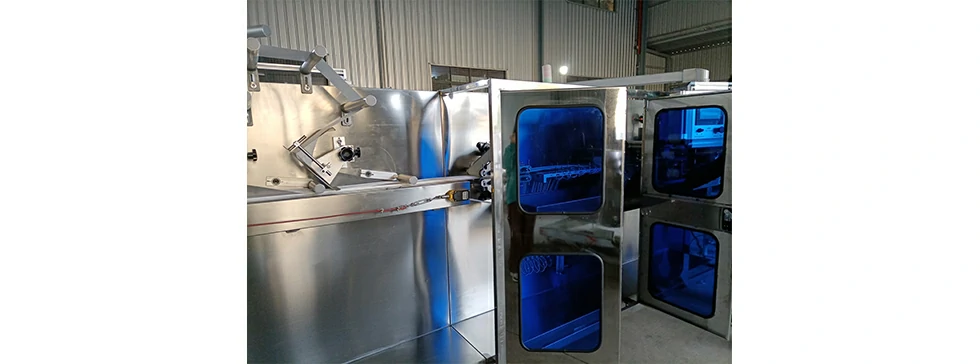Regular calibration significantly impacts the functionality and reliability of wet wipes machines in several ways:
- Accuracy and Precision: Calibration ensures that sensors, detectors, and measuring devices within the machine maintain accurate readings and measurements. This accuracy is crucial for consistent and precise operation.
- Quality Control: Properly calibrated machines maintain product quality by ensuring consistent parameters such as moisture levels, weight, dimensions, and sealing integrity of the wet wipes.
- Optimized Performance: Calibration helps maintain optimal machine performance by ensuring that components are operating within specified tolerances. This prevents deviations that could affect the machine’s efficiency or output.
- Prevention of Errors and Faults: Regular calibration reduces the risk of errors, inaccuracies, or false readings that could lead to malfunctions, production errors, or downtime.
- Compliance with Standards: Many industries have specific standards or regulations regarding product quality and manufacturing processes. Regular calibration ensures compliance with these standards, avoiding penalties or rejections due to non-conformities.
- Early Detection of Issues: Through calibration, inconsistencies or deviations in readings are identified early, allowing for proactive maintenance or adjustments before they escalate into major problems.
- Longevity of Components: Proper calibration can help extend the lifespan of machine components by reducing wear caused by operating outside optimal parameters.
- Improved Safety: In machines where calibration affects safety features or control systems, proper calibration is critical to ensuring a safe working environment for operators and preventing accidents.
- Cost Savings: Regular calibration can reduce the likelihood of unexpected breakdowns or costly repairs by maintaining the machine in optimal condition, thereby reducing overall maintenance costs.
- Data Accuracy and Analysis: Accurate calibration contributes to reliable data collection and analysis,machine to make wet wipes enabling better decision-making for process improvements or optimizations.
- Operational Efficiency: Well-calibrated machines operate more efficiently, minimizing waste, rework, and the need for manual adjustments during production.
In essence, regular calibration is essential for maintaining the accuracy, reliability, and functionality of wet wipes machines. It supports consistent production quality, helps prevent issues, ensures compliance, and contributes to overall operational efficiency and longevity of the machine.
How do you source replacement parts for these machines, and what considerations are important?
Sourcing replacement parts for wet wipes machines involves several considerations to ensure you acquire the right parts promptly and effectively:
- Identify the Parts Needed: Have a clear understanding of the specific parts that require replacement. This includes part numbers, specifications, and any modifications or upgrades needed.
- Authorized Dealers or Suppliers: Prioritize sourcing parts from authorized dealers, manufacturers, or reputable suppliers. They provide genuine parts, ensuring compatibility and quality.
- Compatibility and Specifications: Ensure the replacement parts match the specifications and requirements of your machine model. Consider factors like size, material, compatibility with existing components, and performance standards.
- OEM vs. Aftermarket Parts: Decide between original equipment manufacturer (OEM) parts and aftermarket alternatives. OEM parts offer precise compatibility but might be more expensive. Aftermarket parts might offer cost savings but ensure they meet quality standards.
- Lead Time and Availability: Check the lead time and availability of the parts from different suppliers. Consider the urgency of the repair and choose suppliers who can provide timely delivery.
- Quality and Reliability: Emphasize quality and reliability when sourcing parts. High-quality parts contribute to machine performance, reliability, and longevity.
- Cost Consideration: Compare prices from different suppliers without compromising on quality. Consider the overall value provided by the parts in terms of performance and lifespan.
- Shipping and Handling: Consider shipping costs, handling fees, and logistics when sourcing parts from different suppliers, especially if they’re located in different regions or countries.
- Warranty and Return Policies: Review warranty terms and return policies offered by suppliers. Ensure the parts come with adequate warranty coverage and return options in case of defects or compatibility issues.
- Supplier Reputation and Support: Choose suppliers with a good reputation for customer support and post-sales service. This ensures assistance in case of inquiries, installation issues, or after-sales support.
- Documentation and Tracking: Keep detailed records of purchased parts, including invoices, part numbers, and supplier details. This aids in tracking maintenance history and assists future procurement.
- Cross-Referencing and Consultation: Cross-reference part numbers and consult technical experts or manufacturers if uncertain about compatibility or alternatives.
By considering these factors when sourcing replacement parts for wet wipes machines, you can ensure you obtain the right parts that meet quality standards, compatibility, and delivery timelines, thus optimizing machine performance and reliability.
